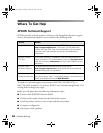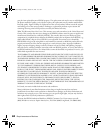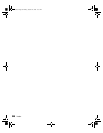
Requirements and Notices
59
■ Be sure your AC power cord meets the relevant local safety standards.
■ Never insert or disconnect the power plug with wet hands.
■ Power-supply cords should be protected from abrasion, cuts, crimping and kinking. Be sure to
place your cords to avoid any damage. Do not place objects on top of the power cord and the AC
adapter or allow the power cord to be stepped on or run over. You should take special care to try to
keep the power cord straight at the ends and the points where it enters and leaves the transformer.
■ Do not place multiple loads on the electrical outlet.
■ Beware of electrical shock hazards.
■ Keep out of reach of children.
■ For US and Canadian users:
Use the included power cord or a 6 to 10 feet long UL-approved type NISPT-2, 2 x 18 AWG cord
with a 125 V 10 A polarized plug and 125 V 7 A connector.
The AC Adapter is equipped with a polarized alternating-current line plug (a plug having one
blade wider than the other) and polarized power inlet. These plugs only fit into a power outlet and
your equipment in one way. This is a safety feature. If you are unable to insert the plug properly,
try reversing the plug. If the plug still fails to fit, contact an electrician to replace your outlet. Be
sure to use only the polarized AC cord that comes with the scanner.
■ Unplug the scanner and AC adapter before cleaning. Clean with a damp cloth only. Do not use
liquid or aerosol cleaners.
■ Do not place the scanner or AC adapter on an unstable surface, near a radiator, or near a heat
source.
■ Do not block or cover the openings in the scanner’s cabinet. Do not insert objects into any
openings as they may touch dangerous voltage points or short out parts.
■ Connect all equipment to properly grounded power outlets. Avoid using outlets on the same
circuit as photocopiers or air control systems that regularly switch on and off.
■ Do not let the power cord become damaged or frayed.
■ If you use an extension cord with the scanner, make sure the total ampere rating of the devices
plugged into the extension cord does not exceed the cord’s ampere rating. Also, make sure the total
ampere rating of all devices plugged into the wall outlet does not exceed the wall outlet’s ampere
rating.
■ Do not attempt to service the scanner and the power cord yourself.
■ Never disassemble, modify, or attempt to repair the AC adapter.
■ Never disassemble or attempt to repair the scanner or optional equipment.
■ Unplug the scanner and refer servicing to qualified service personnel under the following
conditions:
If the power cord or plug is damaged; if liquid has entered the scanner; if the scanner has been
dropped or the case damaged; if the scanner does not operate normally or exhibits a distinct
change in performance. (Do not adjust controls that are not covered by the operating
instructions.)
basics.book Page 59 Monday, October 23, 2000 11:35 AM


















